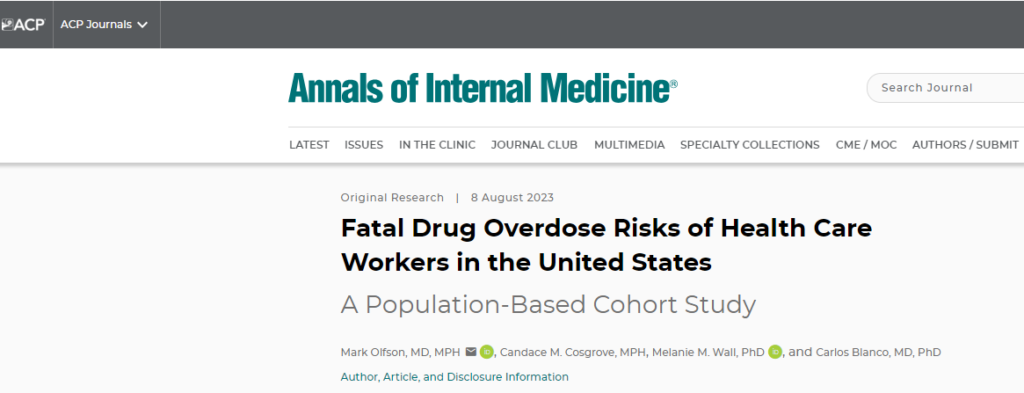the health strategist
knowledge platform
Joaquim Cardoso MSc.
Chief Research and Strategy Officer (CRSO)
Chief Editor and Senior Advisor
August 11, 2023
What is the message?
The study’s findings shed light on the varying risks of fatal drug overdose among different health care worker groups in the United States.
Registered nurses, social or behavioral health workers, and health care support workers were identified as particularly vulnerable to drug overdose death.
These findings emphasize the importance of identifying and intervening with high-risk groups to mitigate drug overdose risks among health care workers.
Key takeaways:
- The escalating epidemic of drug overdose deaths in the United States has raised concerns about the risks faced by health care workers, who often have access to controlled prescription drugs. However, the specific risks associated with various healthcare professions remain largely unexplored.
- This prospective cohort study, published by Annals of Internal Medicine, aimed to assess the risks of drug overdose death among health care workers in comparison to non-health care workers.
- The study involved a large-scale, population-based cohort of participants in the United States. The cohort consisted of 176,000 health care workers and 1,662,000 non-health care workers, all aged 26 years or older.
- Data were collected through surveys in 2008, and participants were followed until 2019 to ascertain causes of death.
- Job stress and burnout may put health care workers at risk for overdose death.
- HRs for overdose deaths were higher for health care support workers, social or behavioral health workers and registered nurses.
- The study calculated age and sex-standardized drug overdose death rates for six distinct health care worker groups, including physicians, registered nurses, other treating or diagnosing health care workers, health technicians, health care support workers, and social or behavioral health workers.
- These rates were then compared to non-health care workers. Additionally, adjusted drug overdose death hazards were evaluated, considering factors such as age, sex, race/ethnicity, marital status, education, income, urban or rural residence, and region.
- The study found that approximately 0.07% of the study sample died from drug overdoses during the follow-up period. Among health care workers, the annual standardized rates of drug overdose death per 100,000 persons varied across professions, ranging from 2.3 for physicians to 15.5 for social or behavioral health workers.
- After adjusting for various demographic factors, the risks of total drug overdose deaths were significantly elevated for social or behavioral health workers (adjusted hazard ratio, 2.55), registered nurses (adjusted hazard ratio, 2.22), and health care support workers (adjusted hazard ratio, 1.60).
- However, the increased risk was not observed for physicians, other treating or diagnosing health care workers, or health technicians. Similar trends were observed for opioid-related and unintentional overdose deaths.

DEEP DIVE

Fatal Drug Overdose Risks of Health Care Workers in the United States – A Population-Based Cohort Study
Annals of Internal Medicine
Mark Olfson, MD, MPH – Candace M. Cosgrove, MPH – Melanie M. Wall, PhD – Carlos Blanco, MD, PhD
August 8, 2023
Abstract
Background:
Despite an unprecedented increase in drug overdose deaths in the United States, the risks faced by U.S. health care workers, who often have access to controlled prescription drugs, are not known.
Objective:
To estimate risks for drug overdose death among health care workers relative to non–health care workers.
Design:
Prospective cohort study.
Setting:
United States.
Participants:
Health care workers (n = 176 000) and non–health care workers (n = 1 662 000) aged 26 years or older surveyed in 2008 and followed for cause of death through 2019.
Measurements:
Age- and sex-standardized drug overdose deaths were determined for 6 health care worker groups (physicians, registered nurses, other treating or diagnosing health care workers, health technicians, health care support workers, and social or behavioral health workers) and non–health care workers. Adjusted drug overdose death hazards (and 95% CIs) were also evaluated, with adjustment for age, sex, race/ethnicity, marital status, education, income, urban or rural residence, and region.
Results:
Approximately 0.07% of our study sample died of a drug overdose during follow-up. Among health care workers, annual standardized rates of drug overdose death per 100 000 persons ranged from 2.3 (95% CI, 0 to 4.8) for physicians to 15.5 (CI, 9.8 to 21.2) for social or behavioral health workers.
Compared with those for non–health care workers, the adjusted hazards of total drug overdose death were significantly increased for social or behavioral health workers (adjusted hazard ratio, 2.55 [CI, 1.74 to 3.73]), registered nurses (adjusted hazard ratio, 2.22 [CI, 1.57 to 3.13]), and health care support workers (adjusted hazard ratio, 1.60 [CI, 1.19 to 2.16]), but not for physicians (adjusted hazard ratio, 0.61 [CI, 0.19 to 1.93]), other treating or diagnosing health care workers (adjusted hazard ratio, 0.93 [CI, 0.44 to 1.95]), or health technicians (adjusted hazard ratio, 1.13 [CI, 0.75 to 1.68]).
Results were generally similar for opioid-related overdose deaths and unintentional overdose deaths.
Limitation:
Unmeasured confounding, uncertain validity of cause of death, and one-time assessment of occupation.
Conclusion:
Registered nurses, social or behavioral health workers, and health care support workers were at increased risk for drug overdose death, suggesting the need to identify and intervene on those at high risk.
Primary Funding Source:
National Heart, Lung, and Blood Institute
Authors and Affiliations
Authors:
Mark Olfson, MD, MPH; Candace M. Cosgrove, MPH; Melanie M. Wall, PhD; Carlos Blanco, MD, PhD
Affiliations:
Department of Psychiatry, Vagelos College of Physicians and Surgeons, Columbia University and the New York State Psychiatric Institute, and Department of Epidemiology, Mailman School of Public Health, Columbia University, New York, New York (M.O.)
United States Census Bureau, Mortality Research Group, Suitland, Maryland (C.M.C.)
Department of Psychiatry, Vagelos College of Physicians and Surgeons, Columbia University and the New York State Psychiatric Institute, New York, New York (M.M.W.)
Division of Epidemiology, Services and Prevention Research, National Institute on Drug Abuse, Rockville, Maryland (C.B.).
Originally published at https://www.acpjournals.org/doi/10.7326/M23-0902












